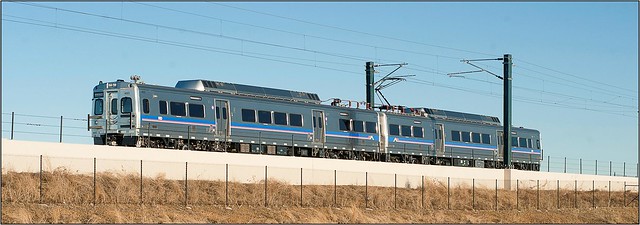 |
| All photos: RTD |
The University of Colorado A Line is 23 miles of rail that is making local and international travel easier than ever. The new line, which opened on April 22, 2016, provides easy, affordable and reliable connections between downtown Denver, Denver International Airport, and the many communities along I-70. With connections at Union Station to the C, E and W light rail lines, the G and B commuter rail lines later this year and local and regional buses, your public transportation options now have an international connection.The international connection is Denver International Airport. In other words, it is now possible for someone in downtown to board a train at Denver Union Station and 37 minutes later, find themselves entering the protected grounds of the Federal TSA, en route to San Francisco, Chicago, Toronto, London, Frankfurt, or even places as foreign and unfamiliar (to LoDo loft owners at least) as Colorado Springs or Grand Junction.

RTD has other rail lines, so why is this one different? Well, not a lot of cities opt for commuter rail. When proposed under the FasTracks plan, instead of a single standard of rail, like all light rail or retrofitting the existing light rail to do all commuter rail, RTD proposed the northern half of the metro area to be served by BRT (bus rapid transit) and commuter rail. This actually makes sense when you consider the effort and the market. Commuter rail's strengths and light rail's comparative weaknesses seem to open up the market to the Hyundai Rotem's Silverliner V cars.
For example, if you board a car, any car, you do so from an elevated platform, rolling luggage and all, and you are (at least in theory) able to move to the least crowded part of the train, even in motion. Another example: if you find yourself worried about making it through security and onto your flight in time, watch the motorman speed it up to 79 and don't sweat the double nickle limit light rail is limited to, a speed benefit of 24 MPH. Commuter rail, for all it's "back east" appearance, really does have its benefits in place for riders.

So, why is the new line called "University of Colorado A Line" by RTD? According again to RTDs site,
RTD is working to establish a long term corporate partnership program to expand revenue opportunities to support a variety of services and programs. The University of Colorado A Line is the first partnership agreement of its kind for RTD and we are excited to implement our first partnership agreement on the line to the airport.In other words, without approval from its constituency, RTD decided to sell the naming rights, akin to city officials feeling entitled to auction the public's interest in naming the stadiums and other buildings built for their use. Never mind that it would be better for clarity for RTD to name the B Line as such because Boulder is home to the main campus.
Opinion
I had an amount of commentary of dubious quality that honestly doesn't need to be aired on this, the A Line's first day of revenue service, and the culmination of a $2.2 Billion project. Instead, I will sum it all up with 3 words:It's. About. Time!
Welcome to the big leagues, Denver. Make rail work for you like it always has and you'll be in good shape.⚒













